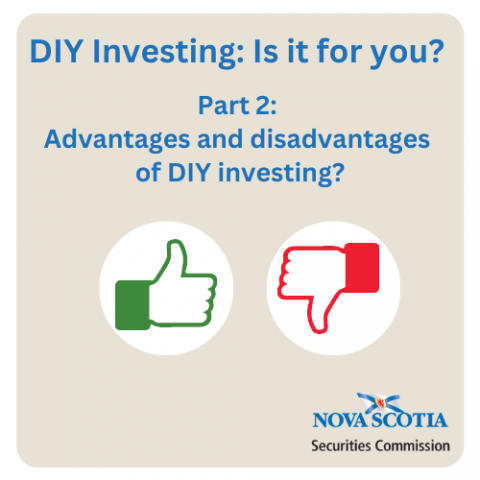Submitted by nsscadmin on

Welcome to Part 2 of our blog series on DIY investing. We got started last week with a look at the basic definition of DIY investing. This week we’ll look at some of the basic advantages and disadvantages of DIY investing. We’ll start with some of the advantages.
Potentially lower fees: By managing your investments yourself you will usually face lower fees than those you may encounter while working with an adviser or investment professional.
Invest directly in your interests: If there are specific companies, industries, funds, indexes or commodities that interest you as an investor, DIY investing allows you to research them and if they fit your portfolio, invest in them directly at your chosen rate.
Total control of your investments: You’re in control of every purchase and sale and can determine how long to hold your investments.
Now, let’s look at some disadvantages of DIY investing:
Potential to make very costly mistakes: If you lack the fundamental understanding of investing you can make some very costly mistakes when DIY investing.
Need for adequate research: If you are unable to do the proper research for any reason you may end up investing in unsuitable or overly risky investments that do not fit your goals and/or financial situation.
Lack of time: DIY investing often takes considerable time. This includes time for research, monitoring your portfolio and being available to buy or sell securities at the right time. Not having the necessary time to dedicate to your DIY investing can be harmful to your financial health.
DIY convenience can lead to impulsive or emotional decisions: One of the major reasons for the rise in DIY investing is how convenient investing has become due to direct market access through mobile devices and computers. This has also led to an increase in impulsive investing based on emotions. Often these decisions are rash and may be financially harmful.
Lack of a financial plan and distractions: To be a successful DIY investor you need a financial plan that considers all aspects of your finances. Lack of a plan, or distractions that take you away from your plan, can lead to poor investment choices or poorly managed portfolios.
If you’re thinking of getting into DIY investing be sure you honestly assess all the advantages and disadvantages to make sure it is right for you and your situation.
Next week we’ll continue our look at DIY investing and whether it is right for you by looking at how you might get started and the options you’ll face.
